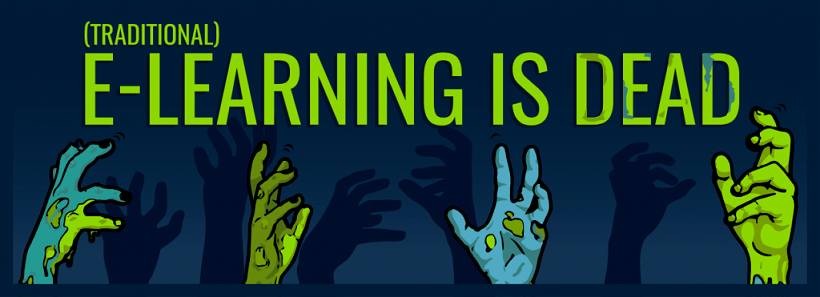5 Reasons Traditional eLearning Needs To Go
It is safe to say that while technology has helped us make big advancements in the industry of eLearning, traditional eLearning approaches, which became popular in the late 90s, still dominate the learning space. Unfortunately, some eLearning providers continue to put their clients through incredibly tedious online training and completely ignore the opportunities that are available to make it a much more exciting and engaging activity.
By "traditional eLearning," I mean those horrible PDFs that some employers send to staff branded as '"eLearning," that are extremely dull, seem to go on forever and have awful stock imagery or sometimes even none at all. A lot of you have probably come across them at some point, I certainly have!
In a desperate attempt to add some form of interactivity to their eLearning, some providers have added "previous" and "next" buttons to their courses and then claim that their courses are interactive. However, their learners are still submitted to the same old text-heavy, boring stuff. The issue ultimately comes down to this: if a resource is almost impossible to learn from, can it still be called eLearning?
So, What Is The Issue With Traditional eLearning?
Apart from being unbelievably boring, here are 5 reasons why "traditional eLearning" needs an overhaul.
1. Poor Retention Rates
Providers of this type of training are still failing to overcome a huge pitfall of the learning process—the forgetting curve. The Ebbinghaus forgetting curve theory claims that we can lose up to 90% of new knowledge within a week. Given that employers want learners to remember the training and trigger behavioral change that boosts productivity, short-term learning isn’t their primary goal (or at least it shouldn't be). Traditional, boring eLearning offers nothing but a tick-box exercise, which once it's over, is forgotten about.
2. Passive And Uninvolved
Good, interactive eLearning actively teaches you. It acts as a guiding hand, leading you through the material while grabbing your attention and engaging you along the way. Poor eLearning does none of this. It passively presents you with pages and pages of dull, dry information, leaving you bored and equally overwhelmed.
The difference is similar to learning by reading a leaflet and learning from a teacher, a teacher whose attention is solely on you. The teacher leads the way but places you in the driving seat. This greater level of involvement is key to a greater learning experience.
Benjamin Franklin said, "Tell me and I forget, show me and I remember, involve me and I learn."
3. Incredibly Mind-Numbing
Clicking or "wading" through pages and pages of text becomes tedious very quickly, leaving learners much more prone to be distracted by their phones, colleagues or emails. eLearning should be engaging and varied throughout to keep learners on their toes; this, in turn, should also stop them from becoming so easily distracted.
4. Lack Of Evaluation
Those using traditional eLearning are probably spending more time on delivering the training than evaluating its effectiveness and success. Whilst traditional eLearning might be able to successfully communicate a few facts throughout the course, the majority of information will be forgotten not long after, without any long-lasting effect. Can you honestly say that your learners have actually learned and taken in what you wanted them to?
The road after effective eLearning should look something like this (based on the Kirkpatrick model of evaluation), here are 5 key points:
- Knowledge
The learner now knows the information. - Skill
Τhey should now be able to perform what they learned from the training. - Attitude (and this is key)
The training has persuaded them that this is the right thing to do and it is worthwhile. - Confidence
The learner has the confidence to do it. - Commitment
They will carry the task out.
5. Inflexible And Unresponsive
We now live in a world where everything is at our fingertips, and more and more people are doing things "on-the-go." eLearning needs to become easily accessible anywhere and on any device, as nobody wants to be restricted to completing a course solely on a desktop. If it fails to meet the needs of a modern workforce, it will fail to engage.
The Next Step
Let’s move beyond just "ticking boxes." Organizations should be implementing eLearning that has genuine meaning behind it, as well as being easily accessible. It should engage the learner, provoke thoughts and crucially, create a long-lasting positive behavioral change.









